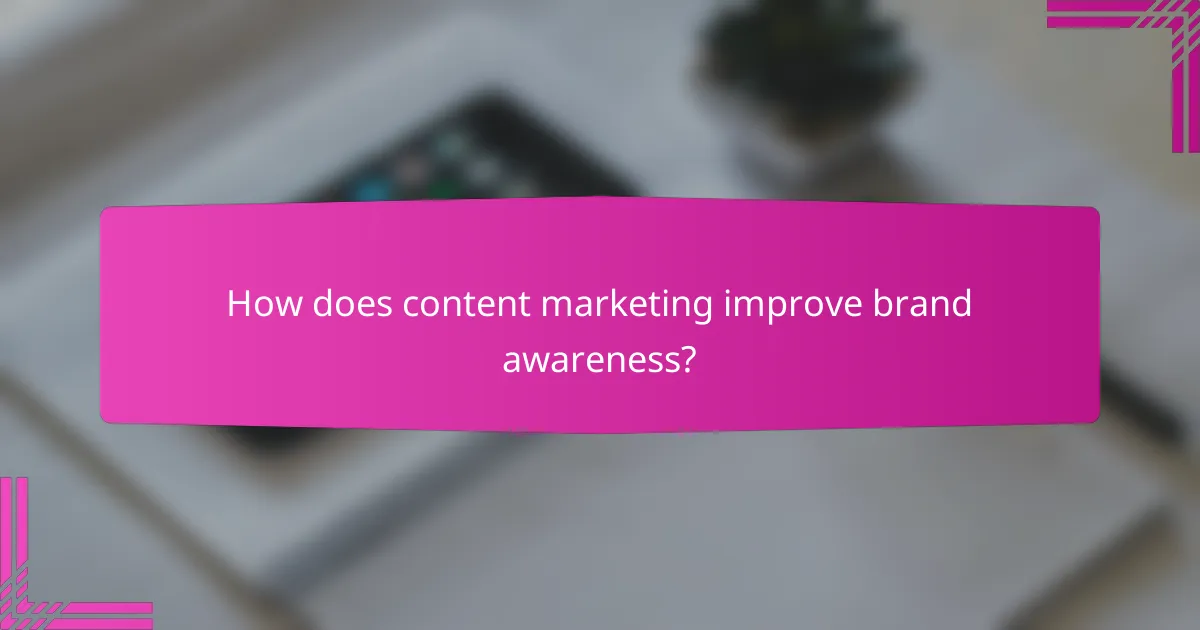Content marketing is a powerful tool for businesses looking to enhance brand awareness and connect with their audience. By developing strategic messaging and effectively targeting specific demographics, companies can create relevant and engaging content that resonates with their market. Understanding audience preferences and utilizing various platforms are crucial for building strong connections and achieving marketing goals.

How to create effective content marketing strategies in Australia?
Creating effective content marketing strategies in Australia involves understanding your audience, setting clear goals, and utilizing various platforms to enhance brand visibility. By focusing on these elements, businesses can build strong connections with their target market and increase brand awareness.
Define target audience
Identifying your target audience is crucial for effective content marketing. In Australia, consider demographics such as age, gender, location, and interests to tailor your messaging. Conduct surveys or use analytics tools to gather insights about your audience’s preferences and behaviors.
Segment your audience into distinct groups to create personalized content. For instance, a brand selling outdoor gear may target adventure enthusiasts, families, and eco-conscious consumers differently, ensuring each segment receives relevant information.
Set clear objectives
Establishing clear objectives helps guide your content marketing efforts. Common goals include increasing brand awareness, generating leads, or boosting customer engagement. Make sure your objectives are specific, measurable, achievable, relevant, and time-bound (SMART).
For example, a goal might be to increase website traffic by 30% over six months through targeted blog posts and social media campaigns. This clarity allows you to track progress and adjust strategies as needed.
Utilize SEO best practices
Incorporating SEO best practices is essential for improving your content’s visibility online. Focus on keyword research to identify terms your audience is searching for, and integrate these keywords naturally into your content. Use tools like Google Keyword Planner to find relevant keywords.
Additionally, optimize on-page elements such as titles, meta descriptions, and headers. Ensure your content is mobile-friendly and loads quickly, as these factors significantly impact search engine rankings in Australia.
Leverage social media platforms
Social media platforms are powerful tools for amplifying your content marketing efforts. In Australia, popular platforms include Facebook, Instagram, LinkedIn, and Twitter. Choose the platforms that align with your target audience’s preferences and where they are most active.
Create engaging content tailored to each platform’s unique characteristics. For instance, use visually appealing images and short videos on Instagram, while sharing in-depth articles and industry insights on LinkedIn to attract professional audiences.
Measure and analyze performance
Regularly measuring and analyzing your content marketing performance is vital for ongoing improvement. Use analytics tools like Google Analytics to track key metrics such as website traffic, engagement rates, and conversion rates. This data helps you understand what works and what doesn’t.
Establish a routine for reviewing performance, such as monthly or quarterly assessments. Adjust your strategies based on insights gained, and consider A/B testing different content types or distribution methods to optimize results over time.

What are the key components of strategic messaging?
Strategic messaging encompasses the essential elements that define how a brand communicates its value to its audience. Key components include brand voice and tone, clarity of the value proposition, and consistency across various channels.
Brand voice and tone
Brand voice refers to the distinct personality and style of communication that a brand adopts, while tone adjusts based on context and audience. Establishing a clear brand voice helps create a recognizable identity that resonates with target audiences.
To develop an effective brand voice, consider your audience’s preferences and the emotions you want to evoke. For instance, a playful tone may suit a children’s toy brand, while a professional tone is more appropriate for a financial services firm.
Value proposition clarity
A clear value proposition articulates the unique benefits and solutions your brand offers to customers. It should answer the question of why a customer should choose your product or service over competitors.
To ensure clarity, keep your value proposition concise and focused. Use simple language and avoid jargon. For example, instead of saying “We provide innovative solutions,” specify “Our software reduces processing time by 30%.” This direct approach enhances understanding and engagement.
Consistent messaging across channels
Consistency in messaging across different channels reinforces brand identity and builds trust with your audience. Whether through social media, email, or website content, maintaining a uniform message helps prevent confusion and strengthens brand recognition.
To achieve consistency, create a messaging framework that outlines key messages, tone, and style guidelines. Regularly review and update content across platforms to ensure alignment. For example, if your social media emphasizes sustainability, your website should reflect the same commitment in its messaging.

How to effectively target audiences in content marketing?
Effectively targeting audiences in content marketing involves understanding their preferences, behaviors, and demographics to create relevant content. By employing strategies like audience segmentation, personalized content, and behavior analysis, brands can enhance engagement and drive conversions.
Use audience segmentation
Audience segmentation is the process of dividing a broad target market into smaller, more defined groups based on shared characteristics. This can include demographics, interests, or purchasing behavior. For instance, a clothing brand might segment its audience by age groups, such as teens, young adults, and seniors, tailoring marketing messages to each segment’s unique preferences.
To implement effective segmentation, consider using tools like surveys or analytics platforms to gather data. This information can help identify key segments and inform content strategies that resonate with each group, ultimately increasing engagement and conversion rates.
Implement personalized content
Personalized content involves creating tailored messages that speak directly to individual audience members based on their preferences and behaviors. This can include personalized emails, product recommendations, or targeted social media ads. For example, an online retailer might send personalized discounts to customers based on their past purchases.
To achieve personalization, utilize customer data and analytics to understand what content resonates with different segments. However, be cautious not to overstep privacy boundaries; always comply with regulations like GDPR when collecting and using personal data.
Analyze audience behavior
Analyzing audience behavior involves tracking how users interact with your content across various platforms. This includes monitoring metrics such as page views, time spent on site, and conversion rates. By understanding these behaviors, marketers can identify what content performs well and what needs improvement.
Utilize tools like Google Analytics or social media insights to gather data on audience interactions. Regularly reviewing this information allows for adjustments in content strategy, ensuring that marketing efforts remain aligned with audience interests and trends. Aim for continuous improvement by testing different content types and formats to see what resonates best.

What tools can enhance content marketing efforts?
Several tools can significantly improve content marketing efforts by streamlining processes, providing insights, and enhancing creativity. Utilizing the right tools can lead to more effective audience targeting, strategic messaging, and increased brand awareness.
HubSpot for automation
HubSpot is a powerful platform for automating various aspects of content marketing, including email campaigns, social media posting, and lead nurturing. Its user-friendly interface allows marketers to set up workflows that trigger actions based on user behavior, which can save time and increase engagement.
Consider using HubSpot’s content management system (CMS) to create and optimize landing pages. This tool provides built-in SEO recommendations and analytics, helping you refine your messaging and improve conversion rates.
Google Analytics for insights
Google Analytics offers valuable insights into website traffic and user behavior, making it essential for evaluating content marketing effectiveness. By tracking metrics like page views, bounce rates, and user demographics, marketers can identify which content resonates with their audience.
Utilize Google Analytics to set up goals and conversions to measure the success of specific campaigns. Regularly reviewing these insights can help you adjust your strategies and focus on the content types that drive the most engagement.
Canva for visual content creation
Canva is an accessible design tool that enables marketers to create visually appealing graphics, infographics, and social media posts without needing extensive design skills. Its drag-and-drop interface and vast library of templates make it easy to produce professional-quality visuals quickly.
When using Canva, consider maintaining brand consistency by utilizing your brand colors and fonts. This will enhance brand awareness and ensure that your visual content aligns with your overall messaging strategy.

How does content marketing improve brand awareness?
Content marketing enhances brand awareness by creating valuable and relevant content that attracts and retains a clearly defined audience. This strategy not only increases visibility but also fosters a connection between the brand and its target market.
Increases online visibility
Content marketing significantly boosts online visibility by optimizing content for search engines. By using relevant keywords and providing high-quality information, brands can improve their rankings on search engine results pages, making it easier for potential customers to find them.
Regularly publishing blog posts, articles, and multimedia content can lead to higher traffic levels. For instance, a well-optimized blog can attract hundreds to thousands of visitors monthly, depending on the niche and competition.
Builds customer trust
Creating informative and helpful content establishes a brand as an authority in its field, which builds customer trust. When consumers find valuable insights and solutions through a brand’s content, they are more likely to view the brand as reliable and credible.
For example, a company offering financial advice can publish guides and tips that help users make informed decisions. This not only enhances trust but can also lead to increased customer loyalty over time.
Encourages audience engagement
Engaging content encourages interaction from the audience, which is crucial for building brand awareness. When users comment, share, or react to content, it amplifies the brand’s reach and fosters a community around it.
Brands can enhance engagement by incorporating calls-to-action, asking questions, or hosting interactive content like polls and quizzes. This not only keeps the audience interested but also provides valuable feedback for future content development.



